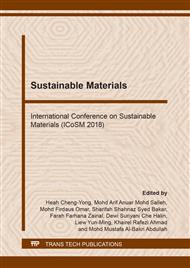p.3
p.9
p.15
p.21
p.26
p.31
p.36
p.43
Effect of Neutron Irradiation on Electrical Properties of Bi2Sr2CaCu2 (Bi-2212) Phase Superconductor
Abstract:
The effect of neutron irradiation on superconducting properties of Bi2Sr2CaCu2 (Bi-2212) phase superconductor was studied. TRIGA MARK II research reactor with neutron flux of 2.00 × 1011 /cm2s was used as the neutron source. Results between non-irradiated and irradiated samples have been analyzed from the aspects of microstructure and electrical properties. In this work, the bulk samples were prepared using the conventional solid-state reaction method. Molar ratio of Bi2O3, Sr2CO3, CaCO3 and CuO were mixed according to its ratio into composition of Bi:Sr:Ca:Cu = 2:2:1:2. The samples were sintered at 840°C during the sample preparation process. Some of the fully synthesized samples were irradiated with neutron irradiation. Neutron irradiation has been proved to promote better flux pinning properties by introducing larger defects in various superconductor ceramics. Enhanced flux pinning centers in the superconductor is responsible in enhancing the critical current, Ic and critical current density, Jc of the irradiated samples. The samples were characterized through X-Ray Diffraction (XRD) and Scanning Electron Microscopy (SEM). The transition temperature, Tc and the Jc were measured by using a cryogenic four-point probe system. The XRD patterns for the non-irradiated and irradiated samples show well-defined peaks of which could be indexed on the basis of the Bi-2212 phase structure. XRD patterns also indicate that irradiation did not affect the Bi-2212 superconducting phase. However, the enhancement of Jc was observed in the neutron irradiated sample and this indicates the effectiveness of .neutron irradiation in creating defects that acted as effective flux pinning centers for vortices.
Info:
Periodical:
Pages:
21-25
Citation:
Online since:
August 2018
Authors:
Price:
Сopyright:
© 2018 Trans Tech Publications Ltd. All Rights Reserved
Share:
Citation:


